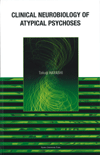Home > Book Detail Page

Takuji Hayashi, currently serving as a Professor(director and chairman) of Psychiatry an Kyoto University, spent most of his academic life investigating the classification of schizophrenic psychoses, particularly, atypical psychoses.
He was born in 1945 and graduated from Kyoto University Medical School in 1970. After he served as attending physician in a private mental hospital for 13 years, while studying under Prof. H. Mitsuda at Osaka Medical College, he became a guest psychiatrist at the University of Bonn (under the guidance of Prof. G. Huber). In 1984, he was hired to join the staff members of Aichi Medical University, and was thereafter promoted to the Professor of Psychiatry. In 2001, he was invited to hold the present position at Kyoto University, Faculty of Medicine and Graduate School of Medicine.
He has written many papers and books on atypical psychoses, and translated the following books from German to Japanese: "Aufteilung der Endogegen Psychosen" (K. Leonhard) and "Psychiatrie" (G. Huber). He also serves as an Editorial Board Member of Neurology, Psychiatry and Brain Research.
He was born in 1945 and graduated from Kyoto University Medical School in 1970. After he served as attending physician in a private mental hospital for 13 years, while studying under Prof. H. Mitsuda at Osaka Medical College, he became a guest psychiatrist at the University of Bonn (under the guidance of Prof. G. Huber). In 1984, he was hired to join the staff members of Aichi Medical University, and was thereafter promoted to the Professor of Psychiatry. In 2001, he was invited to hold the present position at Kyoto University, Faculty of Medicine and Graduate School of Medicine.
He has written many papers and books on atypical psychoses, and translated the following books from German to Japanese: "Aufteilung der Endogegen Psychosen" (K. Leonhard) and "Psychiatrie" (G. Huber). He also serves as an Editorial Board Member of Neurology, Psychiatry and Brain Research.
Foreword
Preface
Part 1. Concept of Atypical Psychoses
Chapter 1. Atypical psychoses in Japan
Chapter 2. Clinical and Sociodemographic Studies of Atypical Psychoses using ICD-10 Criteria
Chapter 3. Are protracted-type acute psychosesreally schizophrenia ?
Part 2. Brain Imaging Approach
Chapter 4. Multivariate Analyses of CT Findings in Typical Schizophrenia and Atypical Psychosis
Chapter 5. 123I-IMP SPECT studies in typical Schizophrenia and atypical psychosis
Chapter 6. Single Photon Emission Computed Tomography (SPECT) Findings using N-Isopropy1-p-[123I] iodoamphetamine (123I-IMP) in Schizophrenia and Atypical Psychosis
Chapter 7. Atypical Psychoses as Distinct from Schizophrenia: Results of Brain Imaging Study and Cluster Analysis thereof
Chapter 8. Magnetic resonance imaging findings in schizophrenia and atypical psychoses
Part 3. Psycho-physiological Approach
Chapter 9. Clinical-electroencephalographic Correlative Studies on Paraphrenic Psychoses
Chapter 10. Electroencephalographic Findings in Patients with DSM-IV Mood Disorder, Schizopherenia, and Other Psychotic Disorders
Chapter 11. Differences in P300 between Schizophrenia and Atypical Psychoses (Mitsuda)
Chapter 12. Differences of Exploratory Eye Movements between Schizophrenia and Atypical Psychoses
Chapter 13. Multivariate analysis of schizophrenic psychoses using psychophysiological data
Part 4. Follow-through Investigation
Chapter 14. A Study of long-term course and clinical outcome for patients with atypical psychoses: Minimum 20-year follow-up
Chapter 15. Long term personel follow-through investigation of atypical psychotic and schizophrenic patients: evidenceof an epileptic component in atypical psychosis
Part 5. Concluding Remarks: What are Atypical Psychoses
Chapter 16. Atypical psychoses and Schneiderian Schizophrenia
Chapter 17. Atypical psychoses and the problems in contemporary psychiatric diagnosis
Acknowledgments
Index
Preface
Part 1. Concept of Atypical Psychoses
Chapter 1. Atypical psychoses in Japan
Chapter 2. Clinical and Sociodemographic Studies of Atypical Psychoses using ICD-10 Criteria
Chapter 3. Are protracted-type acute psychosesreally schizophrenia ?
Part 2. Brain Imaging Approach
Chapter 4. Multivariate Analyses of CT Findings in Typical Schizophrenia and Atypical Psychosis
Chapter 5. 123I-IMP SPECT studies in typical Schizophrenia and atypical psychosis
Chapter 6. Single Photon Emission Computed Tomography (SPECT) Findings using N-Isopropy1-p-[123I] iodoamphetamine (123I-IMP) in Schizophrenia and Atypical Psychosis
Chapter 7. Atypical Psychoses as Distinct from Schizophrenia: Results of Brain Imaging Study and Cluster Analysis thereof
Chapter 8. Magnetic resonance imaging findings in schizophrenia and atypical psychoses
Part 3. Psycho-physiological Approach
Chapter 9. Clinical-electroencephalographic Correlative Studies on Paraphrenic Psychoses
Chapter 10. Electroencephalographic Findings in Patients with DSM-IV Mood Disorder, Schizopherenia, and Other Psychotic Disorders
Chapter 11. Differences in P300 between Schizophrenia and Atypical Psychoses (Mitsuda)
Chapter 12. Differences of Exploratory Eye Movements between Schizophrenia and Atypical Psychoses
Chapter 13. Multivariate analysis of schizophrenic psychoses using psychophysiological data
Part 4. Follow-through Investigation
Chapter 14. A Study of long-term course and clinical outcome for patients with atypical psychoses: Minimum 20-year follow-up
Chapter 15. Long term personel follow-through investigation of atypical psychotic and schizophrenic patients: evidenceof an epileptic component in atypical psychosis
Part 5. Concluding Remarks: What are Atypical Psychoses
Chapter 16. Atypical psychoses and Schneiderian Schizophrenia
Chapter 17. Atypical psychoses and the problems in contemporary psychiatric diagnosis
Acknowledgments
Index










